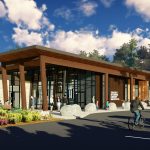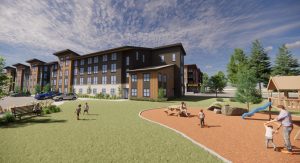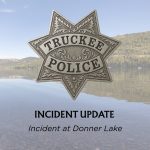TTCF shares wildfire preparedness tips from COAD, sheriffs’ offices
KINGS BEACH, Calif. – Last Friday, the Tahoe Truckee Community Foundation (TTCF) brought together speakers from Community Organizations Active in Disaster (COAD), the Nevada County sheriff’s office and the Placer County sheriff’s office for their Lunch and Learn. The speakers aimed to keep people up to date on wildfire safety and preparedness.
Anne Rarick, COAD manager, spoke first on the role of COAD in the Tahoe-Truckee region. The organization works with local nonprofits, businesses, faith-based communities and the governmental partners to share information and address community needs during and after disasters.
Rarick said that the top five steps they have for disaster preparedness are as follows:
- Get alerts to know what to do. 211 is the non-emergency disaster line, and in Tahoe, you can use Tahoe Alert to see what agency is responsible for notifying you of disasters
- Make a plan to protect your people
- Pack a go bag with things you need (at least 3 days’ worth of items)
- Build a stay box for when you can’t leave (usually for winter storms or shelter in place protocols)
- Help friends and neighbors get ready
Rarick suggested that go bags should contain food, water, snacks, a physical map and emergency contacts written down, in case power isn’t readily available. She also suggested they contain copies of important documents such as prescriptions. The Truckee library is offering appointment slots to help transfer important documents into a zip drive for electronic access.
In North Tahoe, the two alert systems are Placer Alerts for Placer County and the Code Red system for Nevada County. In the town of Truckee and rest of Nevada County, Code Red uses a zone system, which doesn’t list streets, so Rarick recommended that residents write down what zone they are in for easy access.
She also recommended downloading Genasys Protect and Watch Duty: Wildfire Maps to keep track of areas that are being evacuated or are experiencing wildfires. Lastly, Rarick asked people to sign up to be Red Cross Shelter volunteers to bring more hands on deck in case a Red Cross shelter needed to be opened in the area.
Lieutenant Ty Conners of the Placer County sheriff’s office spoke about law enforcement’s role in evacuation, so for unincorporated areas of Placer County, they would be under the sheriff’s office there. He stated that with the Mosquito Fire, it showed that their plan that was in place was effective for evacuation, even in an area with limited road access.
Conners also spoke about unified command scenarios, which help get law enforcement and fire districts to get together and train for disasters like wildfires.
He also addressed why they are unable to post fire evacuation routes—because the fire dictates the roads that they can direct people towards. Conners encouraged people to know possible evacuation routes from main areas and residential areas they live in. Even if they were stuck in traffic, being out of the danger zone is more important, and he encouraged residents to go to designated safety zones when instructed to.
Placer Alerts, which tells people if they need to evacuate, is an opt-in registration for cell phone or email, as landlines automatically receive the notification. Conners specified that they also go door-to-door with unified command in order to alert people who may not hear or have access to alerts. A high-low siren would also be audible in evacuation scenarios.
Lastly, for repopulation, Conners wanted people to be attentive to hazards besides the fire that would stop them from returning to their homes—burned or damaged buildings, power lines down or other issues. “We need to make sure that public works, utility districts, everybody is on the same page that it’s safe to go in. It might be a longer process than you think, but again, our ultimate goal is to get you back in as soon as possible,” he said.
Finally, Sergeant Andrew Liller from Nevada County jumped in to talk about alerts. He recommended Genasys Protect for alerts, and potentially singing up for multiple zones, especially for those who work in a different zone than their house or have family members in other parts of the area.
Liller emphasized for people to know their routes and practice driving them before emergencies happen, keeping the car at least half full of gas during high-risk months for evacuation, leaving early and staying prepared with go bags.
He also addressed concerns around looting when evacuation tags are placed on a house. “When people are putting their own tags on there saying, ‘Hey, you don’t have to check this house, we’re evacuated,’ that helps us get to that next person who may need a little bit more help.”
Their office does still put tags on houses, but he assured people that disaster scenarios bring in more law enforcement through mutual aid, which typically deters looters.
During the Q&A portion of the event, Conners and Liller encouraged people to alert friends, family and neighbors who might not have access to the alerts due to disability, age or other reasons. Conners specified that they have identified critical infrastructure where seniors could be at more risk, but also encouraged seniors to sign up for the alerts, which they could receive assistance with through the 211 number.
An attendee asked how to stay calm during evacuation scenarios, and Conners encouraged planning to prevent panic. Liller recommended that families practice their own evacuation scenarios to alleviate the stress of doing it for the first time during an emergency.
For more tips and information, Kristina Kind, program director at TTCF encouraged people to reach out to COAD at connectingpoint.org/tahoe-truckee-coad-2/ or calling 211.
Eli Ramos is a reporter for Tahoe Daily Tribune. They are part of the 2024–26 cohort of California Local News Fellows through UC Berkeley.
Support Local Journalism


Support Local Journalism
Readers around Lake Tahoe, Truckee, and beyond make the Sierra Sun's work possible. Your financial contribution supports our efforts to deliver quality, locally relevant journalism.
Now more than ever, your support is critical to help us keep our community informed about the evolving coronavirus pandemic and the impact it is having locally. Every contribution, however large or small, will make a difference.
Your donation will help us continue to cover COVID-19 and our other vital local news.










